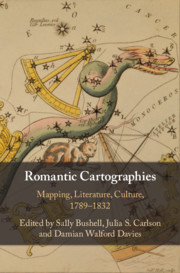Book contents
- Romantic Cartographies
- Romantic Cartographies
- Copyright page
- Contents
- Illustrations
- Notes on Contributors
- Preface
- Acknowledgements
- Introduction Romantic Cartographies
- Part I Romantic Maps, Romantic Mapping
- Part II Cartographic Encounters
- Part III Beyond Romantic Cartographies
- Chapter 9 Deep Mapping and Romanticism
- Chapter 10 Unmapping John Clare
- Chapter 11 The Problem of Precedent
- Chapter 12 Maps without Territory
- Bibliography
- Index
Chapter 12 - Maps without Territory
Disappearing Trelawney Town
from Part III - Beyond Romantic Cartographies
Published online by Cambridge University Press: 15 January 2021
- Romantic Cartographies
- Romantic Cartographies
- Copyright page
- Contents
- Illustrations
- Notes on Contributors
- Preface
- Acknowledgements
- Introduction Romantic Cartographies
- Part I Romantic Maps, Romantic Mapping
- Part II Cartographic Encounters
- Part III Beyond Romantic Cartographies
- Chapter 9 Deep Mapping and Romanticism
- Chapter 10 Unmapping John Clare
- Chapter 11 The Problem of Precedent
- Chapter 12 Maps without Territory
- Bibliography
- Index
Summary
This essay examines the vexed history of Trelawney Town, Jamaica, from its grant by treaty in 1738 to Jamaica’s self-emancipated Maroons until its expropriation by the colonial state after the so-called Second Maroon War (1795–6).Maps provide evidence of the different ways Maroons and their colonial enemies understood territory and their relationship to it.As an imperial practice, cartography both determines state-sanctioned boundaries and distributes the ideological beliefs that enforce them.But it sometimes also records evidence of the way Maroons inhabited their territory. Close examination of pencil notations on maps produced to establish the boundaries of Trelawney Town and its environs reveal the refusal of Maroons to acknowledge their territory as a bounded space. With the inevitable encroachment of patented estates, they rebelled to assert their right to inhabit their territory as they saw fit. Through guile and terror, the colonial state prevailed against them, expropriating their territory and transporting the Trelawney Town Maroons to Nova Scotia. Later maps show the parcelling of their territory into 300-acre plots secured by a central military barracks. So prevails the proprietary space of capital: by force.
Keywords
- Type
- Chapter
- Information
- Romantic CartographiesMapping, Literature, Culture, 1789–1832, pp. 271 - 291Publisher: Cambridge University PressPrint publication year: 2020



